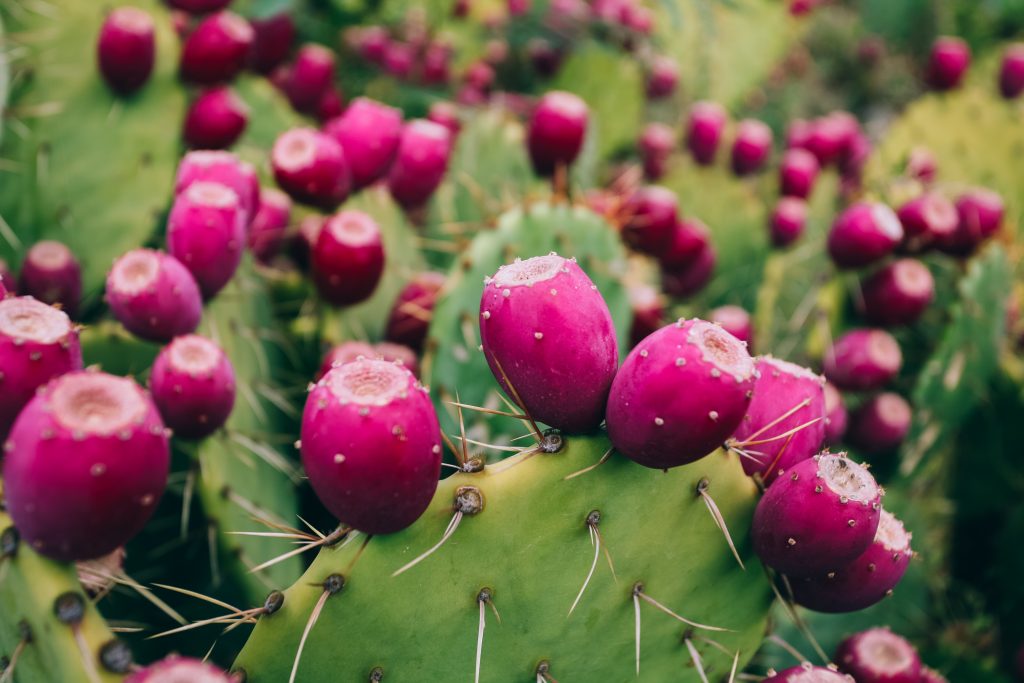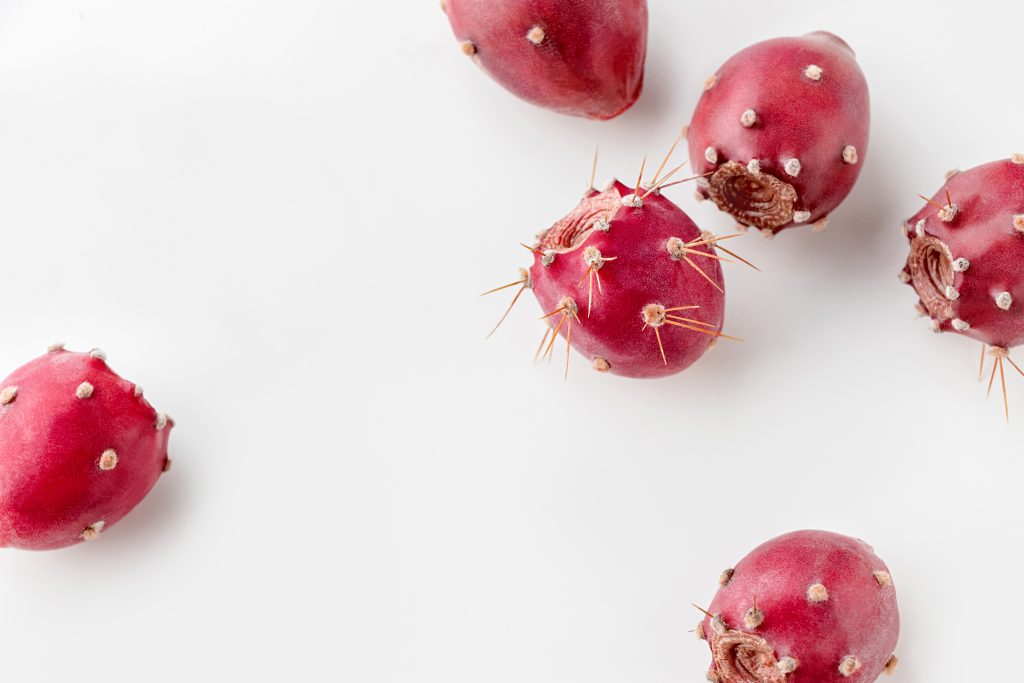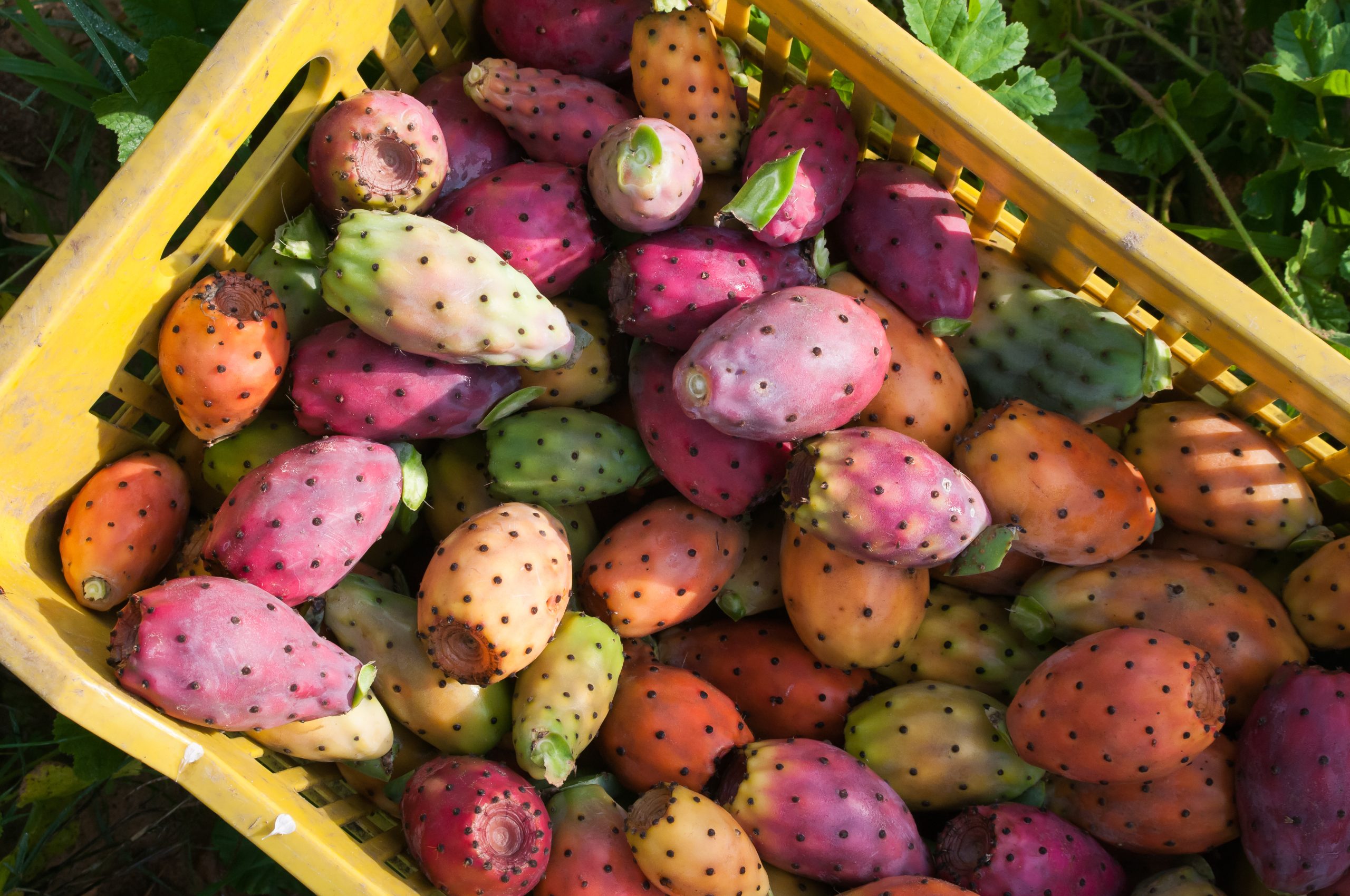The prickly pear may look dangerous, but it has such as delicate and lovely flavor that it tastes like a cross between bubble gum and watermelon. It’s a low-calorie, highly nutritious fruit perfect for morning smoothies or a delightful snack.
Table of Contents
What is a Prickly Pear?
Prickly pears grow from the cactus Opuntia basilaris, a common succulent found in dry regions across North America and South America, most abundant in New Mexico.
It’s also called the nopal cactus, nopalitos, nopals, Indian fig, or cactus pear. They are noted for their spiny paddles that give them their prickly appearance, but inside is a tender fruit that is as soft as a kiwi.
The flavors of prickly pear are very mild, with a gentle kiss of sweetness high in beneficial vitamins and nutrients.
The History of Prickly Pears
These unique red fruits are native to the Americas. The earliest records of pricky pears were noted by Native Americans that used this fruit not only for food but also as medicine and containers.
Early evidence of human consumption notes that all parts of the prickly pear were consumed- spiny paddles and all! Today, prickly pears, such as smoothies and desserts, are used primarily in cooking.
The biggest exporters of prickly pears are found in the southwest United States (in states like New Mexico and Florida) and parts of Mexico.

What Does a Prickly Pear Taste Like?
Surprisingly, the flavors of prickly pears are incredibly mild, without any tartness or bitterness. Many describe the taste as similar to watermelon or kiwi, with a hint of bubblegum flavor.
While the outside is hard, the insides are incredibly soft, with tiny, edible seeds for an added crunch. When cooked into candies, jellies, or jam, it retains its delicate sweetness, and the melon flavors shine through.
How to Tell When Prickly Pear is Ripe
Want to know when a prickly pear is at its peak ripeness? Check out this quick guide below.
| Color | A perfectly ripe prickly pear is electric red with blue-green pads. If there is a hint of green or bright yellow on the outside, that’s ok! It doesn’t mean that the fruit isn’t perfectly ripe. |
| Firmness | The firmness test is the best way to check for ripeness. A ripe prickly pear should feel heavy in your hands and has a slight give to it like an avocado. |
| Smell | When at the peak of ripeness, prickly pears smell incredibly bright and floral. |
| Bruising | If you notice a lot of bruising around the stem, it likely means that your prickly pear is overripe or has been sitting on the store shelf for a long time. |
Are Prickly Pears and Regular Pears Related?
No, prickly pears and pears are not related. Prickly pears come from a prickly pear cactus and are a member of the Cactaceae family, or cactus family. Regular pears grow from trees and are a member of the rose family.
Prickly pears get their name based on their appearance. The term prickly is self-explanatory, as the cactus plants are covered in needles! They earned the name pear because they have a very similar size and shape to a pear, even though the two plants are in no way related.
Can I Eat Raw Prickly Pears?
Yes, prickly pears are great when eaten raw! Of course, you want to make sure that you remove the tough exterior layer before diving in.
Once you remove the tough outside layer, the inside of the prickly pear is incredibly soft and smooth, similar to the texture of a kiwi. In most instances, prickly pear is best consumed raw in smoothies, as a snack, or as a fresh addition to summer salads.
Cooking with Prickly Pears
Before cooking with prickly pears, let’s take a quick look at removing its rugged exterior.
1. Wash your fruit. Since prickly pears grow relatively close to the ground, wash them under cool water.
2. Remove the cladodes (or thorns). Place your prickly pear on a skewer, and place it over an open flame on your stove for around one minute. The fire will burn off the thorns so you can brush them away with a soft cloth.
3. Remove the skin. Cut the end off the prickly pear, then use a knife to make a shallow cut vertically. Once the skin is cut, it should peel away nicely, like the top layer of an onion.

Prickly Pear Juice: Prickly pear juice is one of the best ways to enjoy its natural flavors. It’s naturally vibrant red with a subtle, unique sweetness. For a healthy treat, drink it on its own, or make it boozy for a summery cocktail.
Tenderloin with Prickly Pear Sauce: Prickly pears flavors are so mild and unique that they’re great in savory recipes, like this tenderloin main course. It pairs fragrant tenderloin with the kiss of sweetness from prickly pear, perfect for your next summer BBQ.
Prickly Pear Vinaigrette: Want to take your salads to the next level? This prickly pear vinaigrette is sweet, tart, and savory and is sure to make those lettuce leaves sing. The prickly pears add a unique flavor that tastes, unlike any vinaigrette you’ve ever had.
How to Store Prickly Pear
Whether you store them in the refrigerator or on the countertop, prickly pears will stay fresh for only a few days once they are ripe. Once you cut into the hard skin, they will turn mushy almost immediately (like an avocado).
The best way to store prickly pears for over a few days is to freeze them. Place prickly pears in a freezer bag, which will stay fresh for up to 12 months.
Nutritional Benefits of Prickly Pears
If you are dieting, prickly pears are one excellent diet food. One pear has only 40 calories and contains beneficial vitamins and nutrients.
They are high in dietary fiber, which promotes good gut health and helps keep you from snacking between meals. They are also high in calcium, which helps protect against cancer, diabetes, and keeps your blood pressure low.
Other noteworthy vitamins and nutrients include Vitamin C and antioxidants, which help control blood sugars and keep cholesterol low.
Where to Purchase Prickly Pears
If you live in dry climates near the Mexican border, getting your hands on prickly pear fruit won’t be too difficult. They often appear in most supermarkets when they are in season in September through December.
If you live outside of the southwest United States, you might have to hit up your local farmer’s market or specialty fruit store for these delicacies of the desert.

